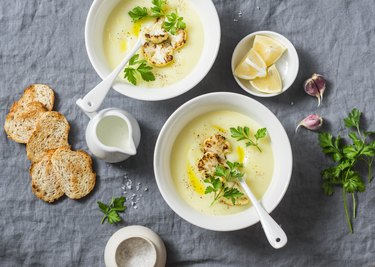
Doctors prescribe a variety of diets for patients in a hospital setting, ranging from a normal diet to nothing by mouth for a designated amount of time. The type of hospital diet depends on the patient's needs and restrictions. For example, a patient just coming out of tonsillectomy surgery will be on a completely different diet than a patient recovering from a broken leg.
Regular or Normal Diets
Video of the Day
Regular diets, also called normal or house diets, are used to maintain or achieve the highest level of nutrition in patients who do not have special needs related to illness or injury. While regular diets do not have portion or choice restrictions, they are altered to meet the patient's needs according to her age, condition and personal beliefs. For example, a pregnant person may require more calories and different nutrients than a young child would need.
Video of the Day
Short-Term Liquid Diets
A full-liquid diet is another type of hospital diet that includes foods that are easier to swallow and digest than solid foods. These diets consist of liquids or foods that are liquid at room temperature. The three types of liquid diets are clear liquid, full liquid and pureed. A doctor typically prescribes a liquid diet as a transitional diet after illness or surgery or in preparation for a test or procedure. Clear liquid diets include water, broth, clear juices such as apple and grape, ice pops and flavored gelatin. Full-liquid diets allow all the liquids in a clear liquid diet plus thicker fluids such as milk, pudding and vegetable juices. A pureed diet allows all foods as long as they are converted to a liquid form in a blender. This type of diet is meant for the short term only. If it is necessary to prolong the diet, calories must be added and may include serving breakfast powder added to milk, puddings and custards, strained meats, and sugar or syrup added to beverages, according to Winchester Hospital.
Read More: List of Foods in the Liquid Diet
Soft Transitional Diets
Soft diets are typically a transition for patients who are not ready for foods of normal consistency following surgery or treatments. These diets consist of foods that are easy to digest while providing needed nutrition. Patients prescribed a soft diet are restricted to foods that can be mashed with a fork. This includes cooked fruits and vegetables, bananas, soft-cooked eggs and tender meats. A mechanical soft diet allows most foods as long as they can be chopped, ground, mashed or pureed to a soft texture. University of Wisconsin Health suggests that this excludes most raw fruits and vegetables with skin and seeds, dried fruits, fried foods, spicy foods, orange or tomato juice, and nuts.
Read More: Soft Food Diet Ideas
Restricted or Special Diets
Restricted diets encompass different types of diets for patients based on their individual requirements. These could include a variety of special diets that limit calories, fat, salt and other substances based on the patient's medical needs. For example, a restricted-fat diet allows only low-fat versions of milk, cheese, cereal and ice cream but does not place limits on the amount of fresh fruit or vegetables a patient may consume." A restricted diet may also modify the other types of diets. For example, a postoperative patient with heart disease may be prescribed a low-fat full-liquid diet.
Read More: Low-Fat, High-Protein Diet Menu
Therapeutic Hospital Diets
Physicians prescribe therapeutic diets to treat disease or illness. Like restricted diets, they can also be used to modify another type of hospital diet. Types of therapeutic diets include diets that modify calorie intake, such as with patients who need a high-calorie diet that promotes weight gain; diets that modify certain nutrients, including protein and carbohydrate levels; diets that increase fluid intake; and diets that accommodate food allergies or intolerance. More than 90 percent of allergic reactions are caused by fish and shellfish, eggs, milk, soy, peanuts, tree nuts and wheat. A therapeutic diet for food allergies consists mostly of whole foods and foods with limited ingredients.